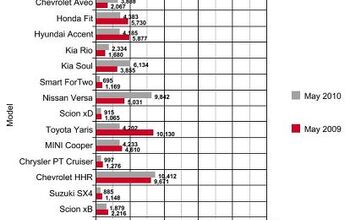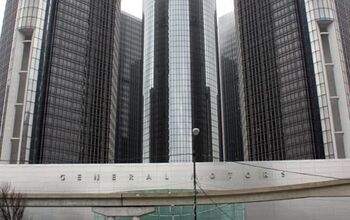May Auto Sales: Fewer And Smaller
May sales estimates are out, and the analysts are seeing slowdown in their crystal balls. Reuters reports that its survey of leading auto analysts projects a 12.6m SAAR (Seasonally Adjusted Annual Rate) for the month, while Bloomberg is projecting a 12.1m rate. Wherever the actual number lands, it is likely to be the first month this year below a 13m SAAR, as Japanese supply interruptions as well as model changeovers lower overall supply. But, reports the WSJ [sub], there’s evidence that perceptions of undersupply are possibly keeping consumers away from showrooms as much as an actual shortage of vehicles. A Honda dealer who says he has plenty of cars for sale is quoted as saying
Traffic is down and I think it’s the media effect. People think there’s no cars and they think there’s no incentives, so they’re waiting.
And that’s not all: it turns out that May’s downbeat forecasts could have an even deeper cause…
The WSJ [sub] also spoke to TrueCar’s VP for Industry Trends and Insight, who argued that May was a “blip,” offering the following evidence:
Three key drivers of auto sales—new home starts, consumer confidence and the Dow Jones Industrial Average stock index—all had down months in May, damping consumers’ eagerness to splurge on new cars.
“The fundamentals that fuel car-buying had a negative month,” he said, adding that he believes it is “very unlikely” the sales pace will dip below the 12 million mark again this year.
Perceptive analysis, to be sure, but what about that other “fundamental that fuels car buying,” gas prices? Another Reuters piece ties rising gas prices (and inflation more generally) to weak consumer spending, noting
The high gasoline prices swallowed almost all the increase in incomes from U.S. tax cuts enacted in December.
Economists worry that stagnant incomes — which have failed to keep up with inflation — will continue to impede spending even though prices at the fuel pump are starting to fall.
So far, consumers have resorted to saving less and some are tapping into their savings to maintain spending. Incomes rose 0.4 percent last month, but disposable incomes adjusted for inflation were flat for a second straight month.
Real incomes have not grown this year and the saving rate stayed at a 2-1/2 year low of 4.9 percent in April. According to the Commerce Department’s chief economist, Mark Doms, Americans saved $82 less over the past four months.
“Consumers have dipped into savings in order to make it through this challenging environment,” said Michael Feroli, an economist at JPMorgan in New York.
“Just as consumers used savings to smooth through the energy price spike on the upside, any move to rebuild saving in the wake of easing gas prices could soften the lift to what otherwise should be a very stimulative development.”
And here we have a macro-level dilemma that could turn May’s “blip” into a longer-term phenomenon: if gas prices resume their steady climb, consumer spending will continue to be eroded away by inflation. If they continue to recede, Americans could well try to build up savings while they can. Only a sudden spike in gas prices seems likely to drive consumers back to the dealerships in large numbers, as sharp runups in gas prices tend to fuel desperate decisions. Meanwhile, cars are getting more expensive and incentives are headed towards some of their lowest levels in years.
The 2008 slide in car sales is starting to feel more like a market correction than a downturn from which we can ever expect a robust recovery… is it any wonder that Bloomberg notes we’re still trying to match that year’s then-disappointing volume? Could this kind of steady, halting, externality-constrained growth be “the new normal”? Since the move towards more efficient cars is being accompanied by improvements in pricing and incentives (and thus, profits), that might not even be the end of the world…
More by Edward Niedermeyer
Latest Car Reviews
Read moreLatest Product Reviews
Read moreRecent Comments
- Master Baiter The picture is of a hydrogen fuel cell vehicle.
- SCE to AUX SAE Level 2 autonomy requires the driver to be the monitor, nothing more.That's the problem, and Tesla complies with this requirement.
- Lou_BC I read an interesting post by a master engine builder. He's having a hard time finding quality parts anywhere. The other issue is most young men don't want to learn the engine building trade. He's got so much work that he will now only work on engines his shop is restoring.
- Tim Myers Can you tell me why in the world Mazda uses the ugliest colors on the MX5? I have a 2017 in Red and besides Black or White, the other colors are horrible for a sports car. I constantly hear this complaint. I wish someone would tell whoever makes theses decisions that they need a more sports car colors available. They’d probably sell a lot more of them. Just saying.
- Dartman EBFlex will soon be able to buy his preferred brand!

































Comments
Join the conversation
Not sure what to make of this. TTAC has done a good job of painting the "new normal" but at some point the supply of low mileage used cars is going to dry up. I also wonder how much youth unemployment is screwing with those numbers. Clearly, if your kids doesn't have a job he doesn't need a beater. Given how long before you get a real job, getting a a new car might be pushed back to 27 or so. At that point, you've got a lot of people married and with kids, which means smaller cars might have issues.
My recollection of the 'tax cuts enacted in December' is that they were merely a continuation of the so-called Bush tax cuts from years before. If I am correct in that, then the rise in fuel prices have actually eaten substantially into disposable income. This - as much as consumer lack of confidence - could explain the sales stagnation, but only in part. Don't forget that we still have an ongoing housing crisis, with prices falling and ownership dropping, not to mention high unemployment or under-employment. A new car purchase will come well after feeding the kids, keeping the house, and paying the utilities.